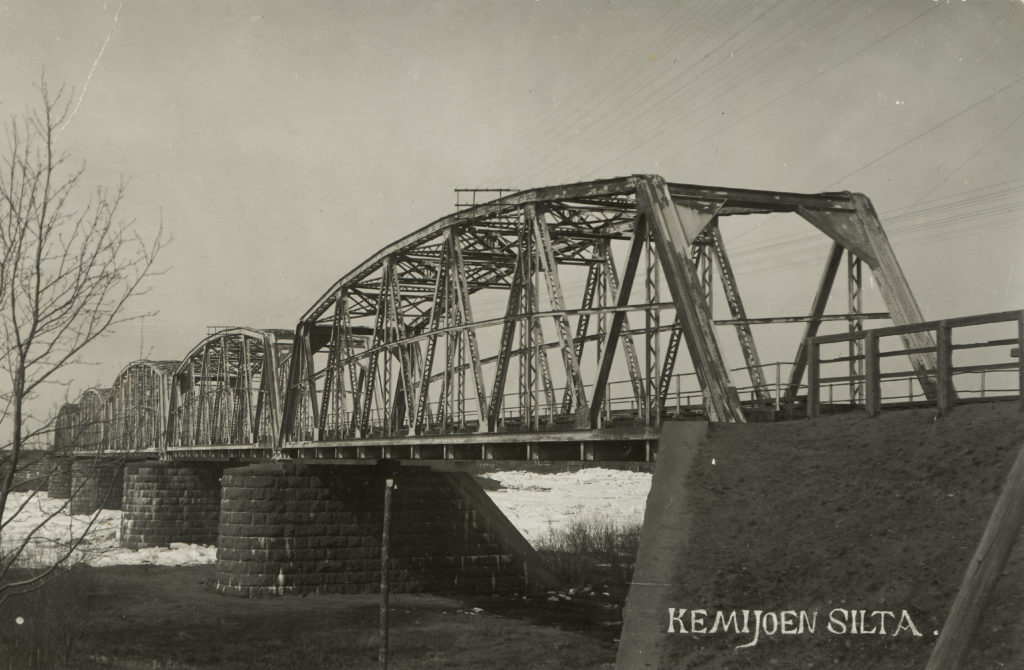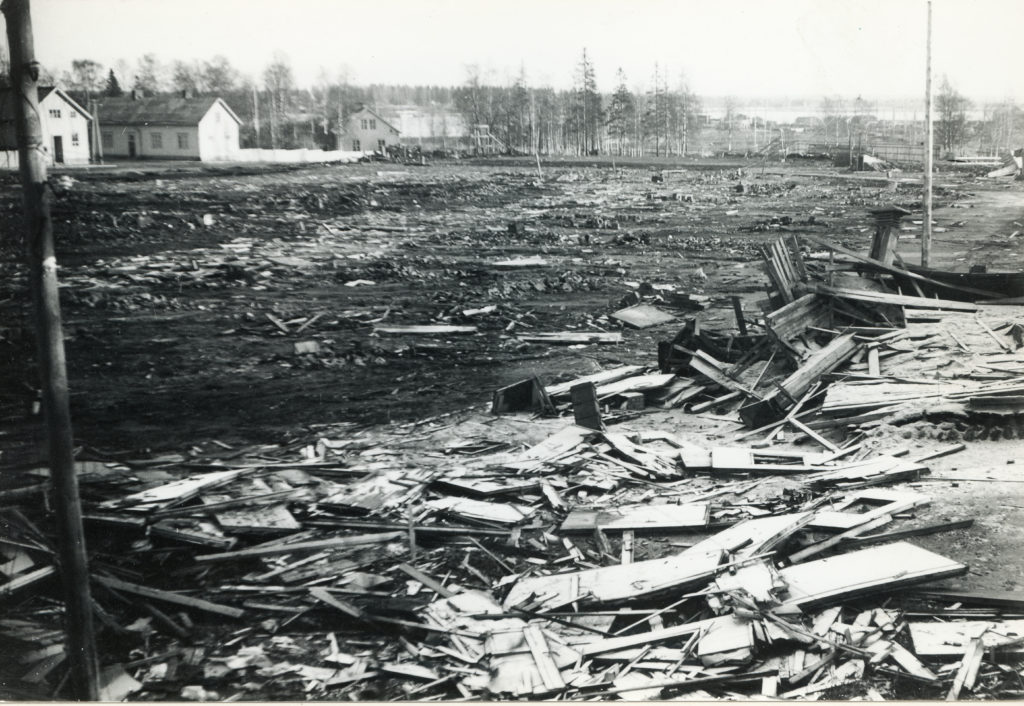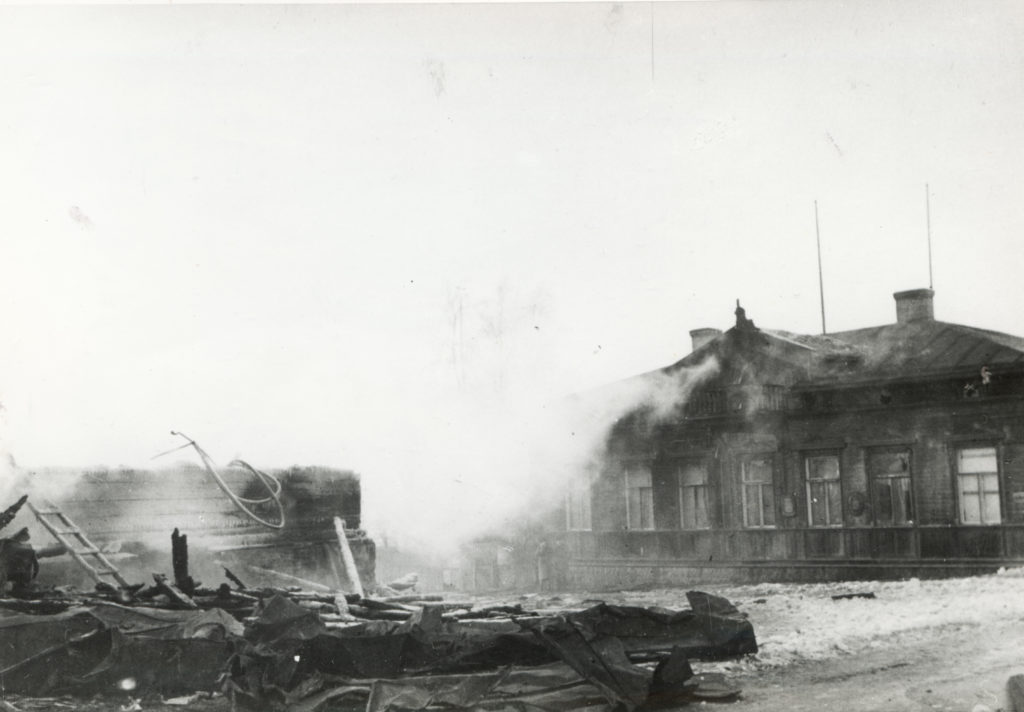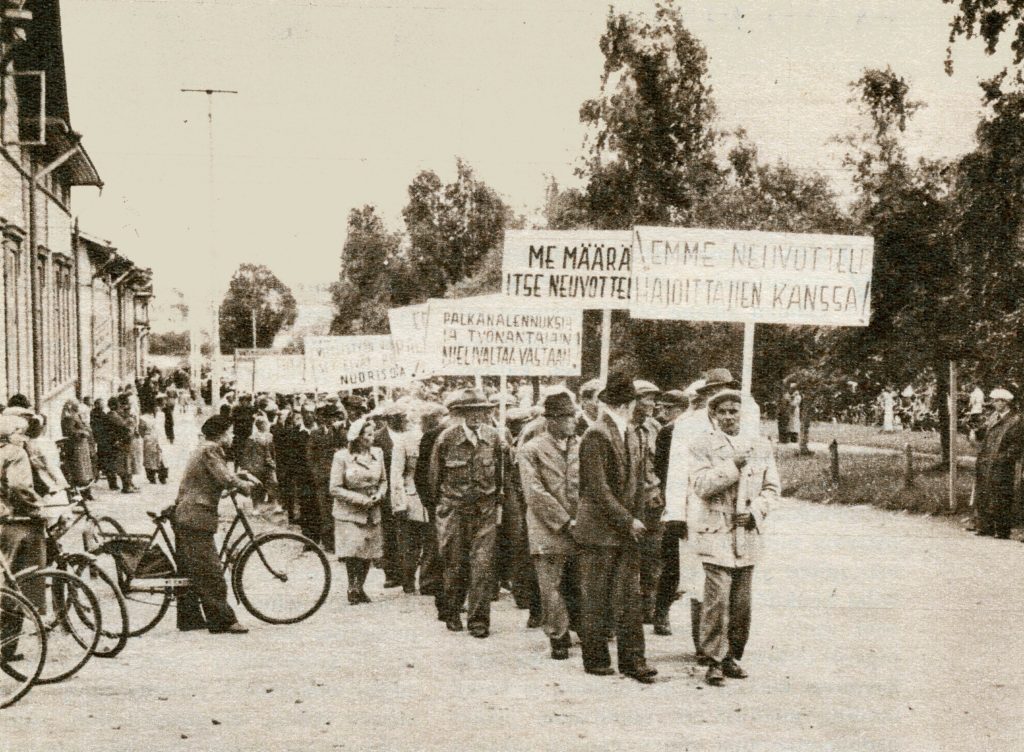Historical Locations
During its more than 150-year history, not only the waves of the sea and the river, but also the waters of world history have lapped up against the shores of Kemi. Periods of oppression, World Wars I and II, the Civil War, the Winter and Continuation Wars, and numerous other subsequent global upheavals have shaped the town in many ways.
Bridges over Kemijoki River
Before the wars, the bridges over the Kemijoki River were visited by curious tourists arriving from afar. The bridges were destroyed by the retreating German army during the Lapland War in October 1944, after which the Isohaara power plant and its dam bridge replaced the old bridges.
Connecting Lapland by rail to the rest of Finland in the early 1900s required an enormous amount of construction work. Dozens of bridges had to be built in places under very difficult conditions. Building bridges across the Kemijoki River was a demanding task, as the building of the high pillars had to be continued even during the cold winter months. The 125-meter-long bridge over Isohaara was once the longest single-arch bridge in Finland. The Vähähaara bridge, on the other hand, had five arches and was 270 meters long.
A new temporary railway bridge was built over the Kemijoki River in 1946 as part of the construction of the Isohaara power plant of Pohjolan Voima. The power plant was completed in 1949.

Kemi Battles 1944
An estimated 200 000 German soldiers were stationed in Lapland during the Continuation War. When the fighting started, there was less than a division’s worth of German troops in Kemi. A condition for the ceasefire with the Soviet Union was that all German soldiers leave Finnish territory within two weeks. At the beginning of the Lapland War, Kemi was almost entirely under German occupation. There was only one special division called Pennanen, known also as Luton miehet (‘Luto men’), whose task was to secure the most important industrial plants.
The battles of Kemi began on the night of October 1, 1944. Finnish troops quickly took over the island of Ajos and proceeded to the Kraasel bridge, which the Germans managed to take back already the next morning. The Germans took up strategic position in Karihaara. Kemi was at war. After four days of waiting, Pennanen got help from the 15th Brigade Combat Division Ojala. The division attacked the Veitsiluoto crossroad and quickly reached Ruonanoja. The main sections of the brigade arrived in Kemi the next day. After this, the brigade commander, Colonel August Kuistio, ordered an attack. The attack, which began on the east side of the city, caught the Germans by surprise, and the brigade managed to surround them almost completely. The goal of the Finns was to take over the airport and the bridges crossing the Kemijoki River. Nevertheless, the Germans had time to destroy them before this happened.
The Kemi battles are considered to have ended on October 8 at 10 a.m. when the Germans blew up the bridges over the Kemijoki River. The town suffered vast damages during the battles. The Germans tried to destroy the town hall, but failed in their attempt. Local industrial plants were damaged by the Germans’ dive-bombing attacks. The handsome wooden elementary school building of Karihaara was completely destroyed in the war. Several commercial and residential buildings were also devastated.

Reading Room Fire
The reading room, located at the intersection of Yrjönkatu and Nahkurinkatu, was the first significant public building in the growing town of Kemi. The two-storey wooden building, designed by the provincial architect A. Tötterström and completed in 1896, was a multi-purpose building of its time. The ground floor housed municipal offices and an elementary school, while the higher floors included a restaurant and ballroom. Locals also played an important role in the creation process, as the building was partly financed from the profits from the sale of liquor.
Over the years, the building housed the municipal administrative court, the magistrate court, the court of appeal, the chamber of treasury, the town library and the reading room, which is why the building was called the reading room. There were also two other local schools in the building, the co-ed school for the bourgeoisie and the Finnish co-ed school. In 1903, the decision was made to transform the building into the town hall.
Soon after, on 13 February 1931, the building and with it all the documents of the city council, the magistrate court and the court of appeal, were destroyed in a fire.

Kemi Strike and Bloody Thursday
After the wars, there was an attempt to improve exports by the wood processing industry through two devaluations that raised the price of consumer goods and the cost of living. In the spring of 1949, several unions demanded wage increases, to which the employers and the Finnish government responded by ordering wage cuts.
The reason behind the Kemi strike was the wages department of the Ministry of Social Affairs demanding that the piece wages of wood processors at Kemi Oy’s Pajusaari plant be reduced by 30-40 percent. The strike at the Pajusaari factory began on July 1, 1949. It initially included 260 wood processors whose piece wages were going to be reduced, but soon the workers of the Kemijoki timber floating site, Karihaara sawmill and the port of Kemi also went on strike. The number of workers on strike rose to several thousand.
Due to the long labour dispute, the strikers staged large demonstrations in Karihaara at the headquarters of Kemi Oy. The situation inevitably reached breaking point when, on August 18, strike breakers began work at the Kemijoki timber floating site. The strikers responded by organising a demonstration with the aim of marching to the work site in Jokisuu. Armed police stopped a procession of nearly three thousand protesters at the eastern end of the Vähähaara dam bridge, where, after a scuffle, a group of forty police officers tried to stop the workers by firing warning shots. One of the protesters, Felix Pietilä, was hit by a bullet and died. Many other strikers were injured in the resulting chaos. Anni Kontiokangas, who had hidden under a truck to escape the bullets, was crushed to death when the truck started to move.
This confrontation, known as Kemi’s Bloody Thursday, is the last political clash that has claimed lives in Finland. In the aftermath of the event, 127 strikers were prosecuted, 63 of whom were punished with various imprisonment sentences for rebellion. The police were acquitted without any convictions. Later, in August, the salaries of workers at Kemi Oy’s production facilities were restored to pre-strike levels.
